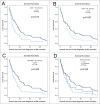Density of tumor-infiltrating lymphocytes correlates with extent of brain edema and overall survival time in patients with brain metastases
- PMID: 26942067
- PMCID: PMC4760339
- DOI: 10.1080/2162402X.2015.1057388
Density of tumor-infiltrating lymphocytes correlates with extent of brain edema and overall survival time in patients with brain metastases
Abstract
The immune microenvironment of the brain differs from that of other organs and the role of tumor-infiltrating lymphocytes (TILs) in brain metastases (BM), one of the most common and devastating complication of cancer, is unclear. We investigated TIL subsets and their prognostic impact in 116 BM specimens using immunohistochemistry for CD3, CD8, CD45RO, FOXP3, PD1 and PD-L1. The Immunoscore was calculated as published previously. Overall, we found TIL infiltration in 115/116 (99.1%) BM specimens. PD-L1 expression was evident in 19/67 (28.4%) BM specimens and showed no correlation with TIL density (p > 0.05). TIL density was not associated with corticosteroid administration (p > 0.05). A significant difference in infiltration density according to TIL subtype was present (p < 0.001; Chi Square); high infiltration was most frequently observed for CD3+ TILs (95/116; 81.9%) and least frequently for PD1+ TILs (18/116; 15.5%; p < 0.001). Highest TIL density was observed in melanoma, followed by renal cell cancer and lung cancer BM (p < 0.001). The density of CD8+ TILs correlated positively with the extent of peritumoral edema seen on pre-operative magnetic resonance imaging (p = 0.031). The density of CD3+ (15 vs. 6 mo; p = 0.015), CD8+ (15 vs. 11 mo; p = 0.030) and CD45RO+ TILs (18 vs. 8 mo; p = 0.006) showed a positive correlation with favorable median OS times. Immunoscore showed significant correlation with survival prognosis (27 vs. 10 mo; p < 0.001). The prognostic impact of Immunoscore was independent from established prognostic parameters at multivariable analysis (HR 0.612, p < 0.001). In conclusion, our data indicate that dense TILs infiltrates are common in BM and correlate with the amount of peritumoral brain edema and survival prognosis, thus identifying the immune system as potential biomarker for cancer patients with CNS affection. Further studies are needed to substantiate our findings.
Keywords: brain metastases; immunoscore; overall survival; prognosis; tumor infiltrating lymphocytes.
Figures



References
-
- Sperduto PW, Berkey B, Gaspar LE, Mehta M, Curran W. A new prognostic index and comparison to three other indices for patients with brain metastases: an analysis of 1,960 patients in the RTOG database. Int J Radiat Oncol, Biol, Phys 2008; 70:510-4; PMID:17931798; http://dx.doi.org/10.1016/j.ijrobp.2007.06.074 - DOI - PubMed
-
- Berghoff AS, Rajky O, Winkler F, Bartsch R, Furtner J, Hainfellner JA, Goodman SL, Weller M, Schittenhelm J, Preusser M. Invasion patterns in brain metastases of solid cancers. Neuro-oncology 2013; 15:1664-72; PMID:24084410; http://dx.doi.org/10.1093/neuonc/not112 - DOI - PMC - PubMed
-
- Hanahan D, Weinberg RA. Hallmarks of cancer: the next generation. Cell 2011; 144:646-74; PMID:21376230; http://dx.doi.org/10.1016/j.cell.2011.02.013 - DOI - PubMed
-
- Fridman WH, Pages F, Sautes-Fridman C, Galon J. The immune contexture in human tumours: impact on clinical outcome. Nat Rev Cancer 2012; 12:298-306; PMID:22419253; http://dx.doi.org/10.1038/nrc3245 - DOI - PubMed
-
- Galon J, Costes A, Sanchez-Cabo F, Kirilovsky A, Mlecnik B, Lagorce-Pages C, Tosolini M, Camus M, Berger A, Wind P et al. . Type, density, and location of immune cells within human colorectal tumors predict clinical outcome. Science 2006; 313:1960-4; PMID:17008531; http://dx.doi.org/10.1126/science.1129139 - DOI - PubMed
Publication types
LinkOut - more resources
Full Text Sources
Other Literature Sources
Research Materials
